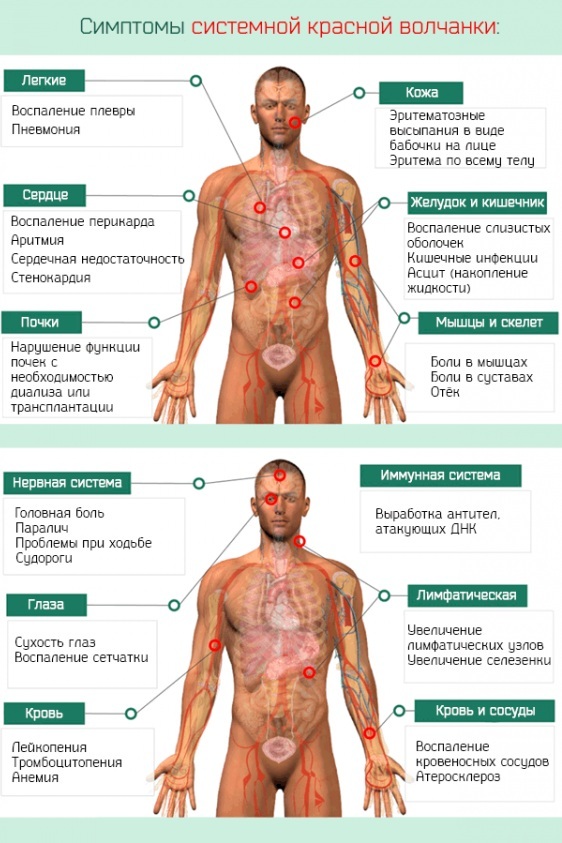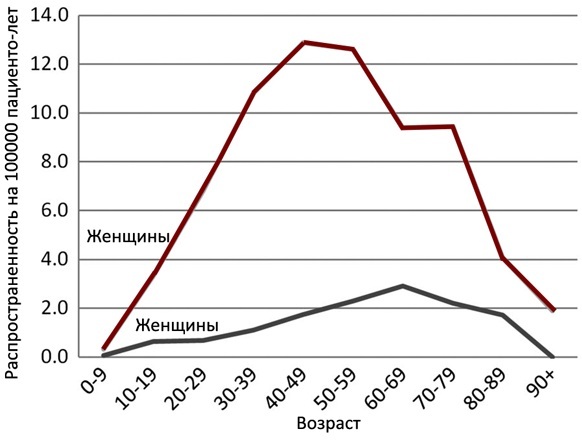Systemic lupus erythematosus is an autoimmune disease that requires complex diagnostics and properly selected therapy. Antibodies produced by the immune system, under the influence of certain factors, accept their cells as foreign.
As a reaction, various disorders and inflammatory processes appear. Examination analyzes are necessary for a doctor to establish an accurate diagnosis and select the most effective treatment.
Record content:
- 1 The reasons for the development of the disease
- 2 Risk factors
- 3 Classification of the disease
- 4 Symptoms of pathology
- 5 Diagnostics
-
6 Treatment of the disease
- 6.1 Medication
- 6.2 Folk remedies
- 6.3 Supportive therapy
- 7 Prognosis and complications
- 8 Comorbidities and pregnancy
- 9 Lupus videos
The reasons for the development of the disease
Physicians cannot reliably tell what causes systemic lupus erythematosus.
However, there are the following provocative sources:
- disruption of the functioning of the endocrine system;
- hypothermia of the body;
- decreased immunity;
- viral or infectious damage to the body.
Comprehensive diagnostics is necessary for the patient when warning signs appear. The physician therapist will conduct an examination and prescribe an examination to make a diagnosis.
Risk factors
There are numerous provoking factors that contribute to the launch of pathological mechanisms:
- prolonged exposure to the sun;
- burns with ultraviolet rays;
- long-term treatment with certain drugs (antibiotics, anticonvulsants);
- strong prolonged stress, emotional stress;
- bad habits (abuse of alcoholic beverages, cigarettes);
- chronic infectious diseases;
- dermatitis of various origins;
- systemic pathologies;
- frequent visits to the solarium;
- the period of bearing the baby and the recovery stage after childbirth.

In patients with systemic lupus erythematosus, the cause of the pathology may be a hereditary predisposition. If parents or close relatives have an autoimmune disease, it is highly likely that the child will also pass on the pathology.
Classification of the disease
In medicine, there is a certain classification of systemic lupus erythematosus, taking into account the course of pathological processes:
| Name | Description |
| Sharp | An aggressive form of the disease that is continuously progressing. The clinical picture grows and intensifies, in some situations the pathology does not lend itself to therapy. Acute systemic lupus erythematosus is more commonly diagnosed in children. |
| Subacute | The disease proceeds with periodic exacerbations, the symptoms are less pronounced. Internal organs are affected during the first year of the progression of pathological processes. |
| Chronic | An autoimmune disease manifests itself for a long time with one or more clinical symptoms. In most cases, it is combined with antiphospholipid syndrome. |

Systemic lupus erythematosus (diagnostics, tests are necessary to establish the cause of the disease and select therapy) as it progresses, there are 3 main stages of development:
- Minimum. The patient is worried about mild headaches, the body temperature periodically rises. General weakness is present, joints hurt. In some situations, symptoms appear on the skin and mucous membranes.
- Moderate. Pathological symptoms appear on the face and body. The disease affects the blood vessels, joints and internal organs.
- Expressed. Systemic lupus erythematosus at this stage is accompanied by severe complications. The disease disrupts the functioning of the brain, internal organs and systems, and the musculoskeletal system.
In addition, systemic lupus erythematosus occurs with the appearance of periodic crises, when the maximum peak of pathological changes is observed. The duration of this stage is 1-14 days.
Symptoms of pathology
The clinical picture of systemic lupus erythematosus will allow the doctor to determine the area of localization of pathological processes, to establish the degree of their development.

| Name | Symptoms |
| Joint damage |
|
| Lesions of the skin and mucous membranes |
|
| Cardiopulmonary manifestations |
|
| Neurological manifestations |
|
| Kidney damage |
|
| Obstetric pathology | In newborns, the disease is diagnosed in 3% of cases when the pathology is transmitted from mother to child. The baby is diagnosed with neonatal lupus, which often goes away on its own during the first years of the baby's life. |
| Hematological manifestations |
|
| Gastrointestinal manifestations |
|

The described clinical signs of systemic lupus erythematosus make it clear that the human body is affected not by the autoimmune pathology itself, but by the complications that arise against the background of its development. Therefore, it is important to timely and correctly differentiate the disease in order to start treatment.
It should be noted that systemic lupus erythematosus is also accompanied by nonspecific clinical symptoms to look out for:
- the body temperature periodically rises for no specific reason, fever, chills appear;
- a person gets tired quickly, even after minor physical exertion;
- muscle weakness occurs;
- red spots appear on the skin that peel off;
- worried about headache and general weakness in the body, malaise;
- there is an exacerbation of chronic diseases.
Many diseases are accompanied by similar symptoms, but they cannot be ignored. In the early stages of development, systemic lupus erythematosus can occur with sluggish symptoms. When the period of remission comes, the person thinks that everything is fine and does not go to the hospital.
At this time, the disease progresses and affects the internal organs, after a while, returning with greater force. Blood vessels and tissues are more affected.
Diagnostics
Comprehensive diagnostics for systemic lupus erythematosus is necessary for an accurate diagnosis. Many diseases are accompanied by similar clinical symptoms, so it is important to differentiate pathological processes.
Systemic lupus erythematosus is diagnosed and analyzed using the following examination methods:
| Name | Description |
| Laboratory tests |
|
| Hardware diagnostics |
|
Comprehensive diagnostics allows not only to establish an accurate diagnosis, but also to determine the state of internal organs that have already suffered from systemic lupus erythematosus. The results also allow us to assess the effectiveness of the therapy, it may be necessary to replace drugs with other drugs.
Treatment of the disease
Systemic lupus erythematosus (diagnostics, tests will help determine the focus of pathological processes and the degree of their development) requires complex symptomatic treatment. The main goal of therapy is to alleviate a person's condition.
The doctor, taking into account the results of a complete diagnosis, selects medication, which is important to take strictly according to the scheme. In the absence of serious contraindications, you can use folk remedies, but after consulting your doctor.
Medication
The doctor selects medications, taking into account the patient's condition and the individual characteristics of his body. It is important to adhere strictly to dosages and prescriptions, since many drugs provoke dangerous side effects.
| Drug group | Name | Application |
| Pain medications | Ibuprofen, Nimesil | The drugs reduce pain, swelling and fever. The adult dosage is selected individually and is 400-600 mg 2-4 times a day. The medicine is taken orally after meals. |
| Antimalarial drugs | Hydroxychloroquine, Plaquenil | The drugs reduce the negative effects of lupus and protect the cardiovascular system. The tablets should be taken after meals and it is recommended to drink them with milk. Adults are prescribed 400-600 mg for treatment, and as maintenance therapy, 200-400 mg once a day. |
| Corticosteroids | Prednisolone, Methylprednisolone | The drugs reduce the development of the inflammatory response. Medication should be taken in the morning with plenty of fluids. Adults are prescribed 5-60 mg once a day for 1-4 weeks. |
| Cytostatics | Azathioprine, Cyclophosphamide | Medicines suppress the increased activity of the immune system. The tablets must be taken orally at 5 mg / kg 2-3 times a day. The course of treatment lasts 1-2 months. |
| Antirheumatic drugs | Rituximab, Belimumab | Medicines are given intravenously through an IV line. The recommended dosage for an adult is 375 mg / m2 Once a week. One course lasts 4 weeks. |

During the treatment of systemic lupus erythematosus, patients should completely exclude physical activity, less sun exposure, use UV protection and avoid stress. In case of damage to small joints, patients are prescribed injections with declofenac. For the treatment of skin rashes, spots and peeling, special ointments and creams are additionally prescribed.
Systemic lupus erythematosus (diagnosis, tests are prescribed by the attending physician to establish the stage and degree of development of the disease) in difficult situations requires the use of extracorporeal therapy:
- Plasmapheresis. The blood is cleansed and some of the plasma is removed during the procedure to reduce the amount of antibodies that work against its own body.
- Hemisorption. Specific sorbents are used, with the help of which the blood is purified outside the body.
Vitamin complexes, immunostimulants and physiotherapy procedures help to support the immune system.
Folk remedies
Prescriptions of healers and healers can be used in the complex treatment of systemic lupus erythematosus, but it is important to consult with your doctor before starting therapy. Many components of folk remedies used can provoke an allergic reaction or individual sensitivity.
| Name | Recipe | Application |
| Eleutherococcus | Pour the root of the plant (100 g) with vodka (500 ml) and leave for 7 days. | The finished tincture should be taken orally, 5 ml 2 times a day. The medicine has anti-inflammatory and antirheumatic effects. |
| Liquorice root | Grind the plant and pour 2 tbsp. hot water (600 ml). Put on a medium heat and heat for 15 minutes. Cool and drain. | The finished medicine is recommended to be consumed 2-3 times a day, 200 ml. The course of treatment lasts 30 days. Licorice root improves blood circulation, restores hormones, has an anti-inflammatory and tonic effect. |
| Chicory, walnut and nightshade | Mix all components in proportions 4: 3: 2. Pour 6 tbsp. ready collection with boiling water (800 ml). Insist 3 hours and strain. | The finished product must be taken orally after meals 3 times a day, 10 ml each. |
| Willow | Pour cold water over the roots and branches of the plant, leave for 30 minutes and dry them, then chop. Put in a saucepan, cover with water and put on fire. Bring to a boil and continue heating for another 20 minutes. Insist the resulting broth for 20 minutes and strain. | The finished product is recommended to be taken orally in 0.5 tbsp. 3 times a day. The course of treatment with willow broth lasts 15 days. |
| Birch buds | Plant buds (1 tablespoon) dry and grind into powder. Add 2 tbsp. vegetable oil. Mix all components well. | It is recommended to treat rashes or spots on the skin with a ready-made product. The procedures are carried out every day 2 times until the symptoms of the disease disappear completely. |

Mountain resin (mummy) contains a large number of useful elements, with the help of which it is restored metabolism, increases immunity, reduces the inflammatory process and accelerates the regeneration of damaged fabrics. It is recommended to use it every day for a month at 200 mg.
Supportive therapy
Systemic lupus erythematosus (diagnostics, tests will help monitor the effectiveness of the use of drugs) requires long-term and correct treatment.
Supportive care involves the use of low-dose corticosteroids to prevent and control worsening of the disease. In some situations, this treatment regimen can reduce the manifestation of side effects to a mild form.
Prognosis and complications
The prognosis for systemic lupus erythematosus depends on the degree of the pathological processes and the area of the lesion.
Without properly selected and timely therapy, dangerous complications await a person:
| Name | Description |
| Cardiosclerosis | The disease is characterized by damage to the heart muscle. There is an overgrowth of connective tissue. Muscle fibers are replaced and the heart valve is deformed. The functioning of the cardiovascular system is impaired. |
| Heart attack | A form of ischemic disease in which the tissue of the heart muscle dies as a result of impaired blood circulation. The heart receives less oxygen, so its functioning deteriorates.
|
| Liver failure | A pathological condition characterized by a violation of one or several liver functions at once. Damage to the organ parenchyma is a common cause. A dangerous condition, as a result of which 50-80% of patients die. |
| Tumor formations | Long-term inflammatory processes in the human body lead to the degeneration of the affected tissues. In such a situation, malignant tumors appear, which provoke certain disorders, given the area of localization in the human body. |
A complication of systemic lupus erythematosus is also pulmonary embolism, cardio-respiratory failure, heart disease, stroke, and internal bleeding. The same applies to gangrene of the lower extremities, the disease occurs against the background of thrombosis.
The prognosis for a quality life is improved if the patient strictly adheres to the regimen. Adheres to prevention, which helps to prevent an exacerbation of the disease, visits a doctor in a timely manner when warning signs appear.
Comorbidities and pregnancy
Pregnancy when diagnosed with systemic lupus erythematosus must be carefully planned and the entire period of gestation of the baby should be under the strict supervision of a gynecologist. It is important to conceive during the period of remission of the disease, since the drugs used during treatment can negatively affect the development of the fetus.
Systemic lupus erythematosus is a serious disease that, even with timely therapy, provokes dangerous complications. Diagnostics and analyzes are necessary to determine the stage of pathological processes, the area of localization. The disease cannot be cured, but with the correct therapy and adherence to all the recommendations of the attending physician, the discomfort can be minimized as much as possible.
Lupus videos
Malysheva about systemic lupus erythematosus:



